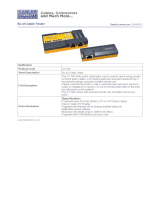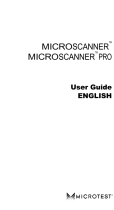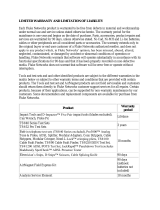Page is loading ...

March 2019
©2019 Fluke Corporation
All product names are trademarks of their respective companies.
MicroScanner
™
Series
Cable Verifiers
Users Manual

LIMITED WARRANTY AND LIMITATION OF LIABILITY
Each Fluke Networks product is warranted to be free from defects in material and workmanship under normal use and service
unless stated otherwise herein. The warranty period for the mainframe and wiremap adapter is one year and begins on the
date of purchase. Parts, accessories, product repairs and services are warranted for 90 days, unless otherwise stated. Ni-Cad, Ni-
MH and Li-Ion batteries, cables or other peripherals are all considered parts or accessories. The warranty extends only to the
original buyer or end user customer of a Fluke Networks authorized reseller, and does not apply to any product which, in Fluke
Networks’ opinion, has been misused, abused, altered, neglected, contaminated, or damaged by accident or abnormal
conditions of operation or handling. Fluke Networks warrants that software will operate substantially in accordance with its
functional specifications for 90 days and that it has been properly recorded on non-defective media. Fluke Networks does not
warrant that software will be error free or operate without interruption.
Fluke Networks authorized resellers shall extend this warranty on new and unused products to end-user customers only but
have no authority to extend a greater or different warranty on behalf of Fluke Networks. Warranty support is available only if
product is purchased through a Fluke Networks authorized sales outlet or Buyer has paid the applicable international price. To
the extent permitted by law, Fluke Networks reserves the right to invoice Buyer for repair/replacement when a product
purchased in one country is submitted for repair in another country.
For a list of authorized resellers, visit www.flukenetworks.com/wheretobuy.
Fluke Networks warranty obligation is limited, at Fluke Networks option, to refund of the purchase price, free of charge repair,
or replacement of a defective product which is returned to a Fluke Networks authorized service center within the warranty
period.
To obtain warranty service, contact your nearest Fluke Networks authorized service center to obtain return authorization
information, then send the product to that service center, with a description of the difficulty, postage and insurance prepaid
(FOB destination). Fluke Networks assumes no risk for damage in transit. Following warranty repair, the product will be
returned to Buyer, transportation prepaid (FOB destination). If Fluke Networks determines that failure was caused by neglect,
misuse, contamination, alteration, accident or abnormal condition of operation or handling, or normal wear and tear of
mechanical components, Fluke Networks will provide an estimate of repair costs and obtain authorization before commencing
the work. Following repair, the product will be returned to the Buyer transportation prepaid and the Buyer will be billed for
the repair and return transportation charges (FOB Shipping point).
THIS WARRANTY IS BUYER’S SOLE AND EXCLUSIVE REMEDY AND IS IN LIEU OF ALL OTHER WARRANTIES, EXPRESS OR IMPLIED,
INCLUDING BUT NOT LIMITED TO ANY IMPLIED WARRANTY OF MERCHANTABILITY OR FITNESS FOR A PARTICULAR PURPOSE.
FLUKE NETWORKS SHALL NOT BE LIABLE FOR ANY SPECIAL, INDIRECT, INCIDENTAL OR CONSEQUENTIAL DAMAGES OR LOSSES,
INCLUDING LOSS OF DATA, ARISING FROM ANY CAUSE OR THEORY.
Since some countries or states do not allow limitation of the term of an implied warranty, or exclusion or limitation of
incidental or consequential damages, the limitations and exclusions of this warranty may not apply to every buyer. If any
provision of this Warranty is held invalid or unenforceable by a court or other decision-maker of competent jurisdiction, such
holding will not affect the validity or enforceability of any other provision.
4/15-MS
Fluke Networks
PO Box 777
Everett, WA 98206-0777
USA

i
Contents
Title Page
Introduction .......................................................................................................................................................................... 1
Registration ........................................................................................................................................................................... 2
Contacting Fluke Networks .................................................................................................................................................. 2
Symbols .................................................................................................................................................................................. 2
WS
afety Information ........................................................................................................................................................ 4
MicroScanner PoE Features .................................................................................................................................................. 7
MicroScanner PoE Display Features ..................................................................................................................................... 9
MicroScanner
2
Features ........................................................................................................................................................ 11
MicroScanner
2
Display Features ........................................................................................................................................... 13
Auto Shutoff ......................................................................................................................................................................... 14
Changing the Length Units .................................................................................................................................................. 14
Using the Wiremap Adapter and Remote ID Locators ....................................................................................................... 15
Testing Twisted Pair Cabling ................................................................................................................................................ 16
Open on Twisted Pair Cabling ...................................................................................................................................... 17

MicroScanner Series Cable Verifiers
Users Manual
ii
Typical Causes of Opens ......................................................................................................................................... 17
Short on Twisted Pair Cabling ....................................................................................................................................... 18
Typical Causes of Shorts .......................................................................................................................................... 18
Crossed Wires ................................................................................................................................................................. 19
Crossed Pairs ................................................................................................................................................................... 19
Typical Causes of Crossed Pairs .............................................................................................................................. 19
Split Pair .......................................................................................................................................................................... 20
Telephone Voltages Detected ....................................................................................................................................... 21
Bridge Tap Detected ...................................................................................................................................................... 23
Ethernet Port Detected .................................................................................................................................................. 25
Viewing Details for a Wire Pair ..................................................................................................................................... 27
Using Multiple Remote ID Locators .............................................................................................................................. 29
Connecting to Telephone Networks Wired in Star Topologies ................................................................................... 31
Connecting to Telephone Networks Wired in Bus Topologies ................................................................................... 33
Testing Coaxial Cabling (MicroScanner
2
) ............................................................................................................................. 35
Results for a Good Coaxial Cable .................................................................................................................................. 36
Open on Coaxial Cabling ............................................................................................................................................... 36
Short on Coaxial Cabling ............................................................................................................................................... 37
Unknown Termination on Coaxial Cabling .................................................................................................................. 37
Detecting Power Over Ethernet ........................................................................................................................................... 38

Contents
iii
MicroScanner
2
................................................................................................................................................................ 38
MicroScanner PoE .......................................................................................................................................................... 39
Using the Toner ..................................................................................................................................................................... 46
Toning in IntelliTone Mode (optional IntelliTone probe required) ............................................................................ 46
Analog Toner Mode (optional tone probe required) .................................................................................................. 49
Using the SmartTone Function ..................................................................................................................................... 50
Using the IntelliTone Cable Map Function (optional IP200 probe required) .................................................................... 51
Calibrating Length Measurements ...................................................................................................................................... 52
Setting the NVP to a Specified Value ........................................................................................................................... 53
Determining a Cable’s Actual NVP ............................................................................................................................... 53
Maintenance ......................................................................................................................................................................... 54
Cleaning ......................................................................................................................................................................... 54
Battery Life, Status, and Replacement ......................................................................................................................... 54
Checking the Tester’s Version, Serial Number, and MAC Address ..................................................................................... 55
Learn More ............................................................................................................................................................................ 55
If Something Seems Wrong with the Tester ....................................................................................................................... 56
Options and Accessories ....................................................................................................................................................... 57
Specifications ......................................................................................................................................................................... 57
Environmental Specifications ........................................................................................................................................ 57
General Specifications ................................................................................................................................................... 58

MicroScanner Series Cable Verifiers
Users Manual
iv
Test Modes ...................................................................................................................................................................... 59
Performance Specifications ........................................................................................................................................... 59
Regulatory Information ................................................................................................................................................. 61

v
Figures
Figure Page
1. High Voltage Display Examples..................................................................................................................... 6
2. MicroScanner PoE Features ........................................................................................................................... 7
3. MicroScanner PoE Display Features............................................................................................................... 9
4. MicroScanner
2
Features ................................................................................................................................. 11
5. MicroScanner
2
Display Features .................................................................................................................... 13
6. Connecting a Remote ID Locator in a Confined Area or to an RJ11 Jack................................................... 15
7. Connecting to Twisted Pair Network Cabling .............................................................................................. 16
8. Open on Twisted Pair Cabling....................................................................................................................... 17
9. Short on Twisted Pair Cabling ....................................................................................................................... 18
10. Crossed Wires ................................................................................................................................................. 19
11. Crossed Pairs ................................................................................................................................................... 20
12. Split Pair.......................................................................................................................................................... 21
13. Telephone Voltages Detected ....................................................................................................................... 22
14. Bridge Tap Detected ...................................................................................................................................... 24

MicroScanner Series Cable Verifiers
Users Manual
vi
15. Active Ethernet Port Detected....................................................................................................................... 25
16. Inactive Ethernet Port Detected .................................................................................................................... 26
17. Details for a Short (MicroScanner
2
screen shown) ....................................................................................... 27
18. Details for Terminated and Open Wire Pairs................................................................................................ 28
19. Using Multiple Remote ID Locators (MicroScanner PoE shown) ................................................................. 30
20. Connecting to a Telephone Network Wired in a Star Topology................................................................. 32
21. Connecting to a Telephone Network Wired in a Bus Topology.................................................................. 34
22. Connecting to Coaxial Cabling (MicroScanner
2
)........................................................................................... 35
23. Coaxial Results (MicroScanner
2
) .................................................................................................................... 36
24. Open on Coaxial Cabling (MicroScanner
2
).................................................................................................... 36
25. Short on Coaxial Cabling (MicroScanner
2
).................................................................................................... 37
26. Unknown Termination on Coaxial Cabling (MicroScanner
2
)....................................................................... 37
27. MicroScanner
2
PoE Display ............................................................................................................................ 38
28. PoE from a Source that Provides Only Single-Signature PoE (MicroScanner PoE) ..................................... 40
29. PoE from a Dual-Signature PoE Source (MicroScanner PoE)........................................................................ 41
30. Detail Screens for Classes 5 and 4 PoE from a Dual Signature Source (MicroScanner PoE)....................... 42
31. PoE Port that Shows 0.0 W............................................................................................................................. 44
32. Passive Power (MicroScanner PoE) ................................................................................................................ 45
33. IntelliTone Toner Mode Display .................................................................................................................... 47
34. Using the Toner in IntelliTone Mode ............................................................................................................ 48

List of Figures
vii
35. Analog Toner Mode Display.......................................................................................................................... 49
36. Using the Toner with the IP200 IntelliTone Cable Map Function ............................................................... 52
37. Replacing the Tester’s Batteries .................................................................................................................... 55

MicroScanner Series Cable Verifiers
Users Manual
viii

1
MicroScanner
™
Series Cable Verifiers
Introduction
The MicroScanner
2
and MicroScanner PoE Cable Verifiers
are hand-held test instrument that let you verify and
troubleshoot the wiring of twisted pair and coaxial cables
and detect network services.
The testers do the following:
•
Measure length u
p to 1000 ft (305 m).
•
Detects opens, shorts, and split pairs on twisted pair
cabling. The MicroScanner
2
also detects faults on
coaxial cabling.
•
Displays wiremap, cable length, proportional
distance to opens, and the remote ID number all on
one screen.
•
Detects Ethernet ports on twisted pair cabling and
reports the port speed.
•
Detects PoE (Power over Ethernet) and telephone
voltages on twisted pair cabling.
•
IntelliTone
™
function works with an optional Fluke
Networks IntelliTone probe to help you locate and
isolate cables behind walls, at patch panels, or in
bundles. The analog toner works with standard
analog probes and includes the SmartTone
™
function
for positive identification of cables in bundles.

MicroScanner Series
Cable Verifiers
Users Manual
2
Registration
Registering your product with Fluke Networks gives you
access to valuable information on product updates,
troubleshooting tips, and other support services. To register,
fill out the online registration form on the Fluke Networks
website at www.flukenetworks.com/register.
Contacting Fluke Networks
www.flukenetworks.com/support
1-800-283-5853, +1-425-446-5500
Fluke Networks
6920 Seaway Boulevard, MS 143F
Everett WA 98203 USA
Fluke Networks operates in more than 50 countries
worldwide. For more contact information, go to our
website.
Symbols
Table 1 describes the symbols used on the tester and in this
manual.
Table 1. Symbols
W
Warning or Caution: risk of damage or
destruction to equipment or software. See
explanations in the manual.
On the tester’s display this symbol indicates a
cable fault or voltage on the cable.
X
Warning: Risk of electric shock.
See the user documentation
~
This product complies with the WEEE Directive
marking requirements. The affixed label
indicates that you must not discard this
electrical/electronic product in domestic
household waste. Product Category: With
reference to the equipment types in the WEEE
Directive Annex I, this product is classed as
category 9 “Monitoring and Control
Instrumentation” product. Do not dispose of
this product as unsorted municipal waste. To
return unwanted products, contact the
manufacturer’s web site shown on the product
or your local sales office or distributor.
j
This equipment not for connection to public
communications networks, such as active
telephone systems.

WSafety Information
3
WSafety Information
WWarningX
To avoid possible fire, electric shock, or personal
injury:
•
Read all safety information before you use the
Product.
•
Carefully read all instructions.
•
Do not open the case. You cannot repair or
replace parts in the case.
•
Do not modify the Product.
•
Use only replacement parts that are approved by
Fluke Networks.
•
Do not touch voltages > 30 V AC rms, 42 V AC
peak, or 60 V DC.
•
The tester is not intended to be connected to
active telephone inputs, systems, or equipment,
including ISDN devices. Exposure to the voltages
applied by these interfaces may damage the
tester and create a potential shock hazard. The
tester shows a warning symbol (
W) when it
detects high voltage. Figures 1 and 13 show
P
Conformite Europeene. Conforms to the
requirements of the European Union and the
European Free Trade Association (EFTA).
Conforms to relevant Australian standards.
40 year Environment Friendly Use Period (EFUP)
under China Regulation - Administrative
Measure on the Control of Pollution Caused by
Electronic Information Products. This is the
period of time before any of the identified
hazardous substances are likely to leak out,
causing possible harm to health and the
environment.
EMC approval for Korea.
Class A Equipment (Industrial Broadcasting &
Communication Equipment).
This product meets requirements for industrial
(Class A) electromagnetic wave equipment and
the seller or user should take notice of it. This
equipment is intended for use in business
environments and is not to be used in homes.
Table 1. Symbols (continued)

MicroScanner Series
Cable Verifiers
Users Manual
4
examples of this display. Disconnect the tester if it
detects high voltage.
•
Do not use the Product around explosive gas,
vapor, or in damp or wet environments.
•
Use this Product indoors only.
•
Do not connect the Product to voltages that are
higher than the maximum voltage rating for the
Product.
•
For Products that have multiple connectors for
different types of tests on copper cabling,
disconnect unused test leads from the
connectors before you do a test.
•
Use the Product only as specified, or the
protection supplied by the Product can be
compromised.
•
Do not use and disable the Product if it is
damaged.
•
Do not use the Product if it operates incorrectly.
•
Batteries contain hazardous chemicals that can
cause burns or explode. If exposure to chemicals
occurs, clean with water and get medical aid.
•
Remove the batteries if the Product is not used
for an extended period of time, or if stored in
temperatures above 50 °C. If the batteries are
not removed, battery leakage can damage the
Product.
•
The battery door must be closed and locked
before you operate the Product.
•
Repair the Product before use if the battery
leaks.
•
Replace the batteries when the low battery
indicator shows to prevent incorrect
measurements. (see "Battery Life, Status, and
Replacement" on page 54)
•
Turn off the Product and disconnect all test
leads, patch cords, and cables before you replace
the battery.
•
Be sure that the battery polarity is correct to
prevent battery leakage.
•
Do not disassemble or crush battery cells and
battery packs.
•
Do not operate the Product with covers removed
or the case open. Hazardous voltage exposure is
possible.
•
Remove the input signals before you clean the
Product.

WSafety Information
5
•
Have an approved technician repair the Product.
•
Do not put metal objects into connectors.
•
Before using the optional IntelliTone probe, read
the safety information in the probe’s
documentation.
EGK29.EPS
Figure 1. High Voltage Display Examples
MicroScanner PoE MicroScanner
2
Positive
Negative

MicroScanner Series
Cable Verifiers
Users Manual
6
MicroScanner PoE Features
EGK32.EPS
Figure 2. MicroScanner PoE Features
J
H
I
A
E
F
B
C
G
D

MicroScanner PoE Features
7
On/off key.
: Turns on the toner.
: Starts the cable test.
: Starts the Power over Ethernet test.
: Scrolls through screens and changes settings. In
toner mode, this key cycles through the IntelliTone and
analog toner songs.
For additional modes, hold down keys while turning the
tester on:
•
+ : Lets you calibrate length measurements
and select meters or feet as the length unit. See
pages 14 and 52.
•
+ : Activates a demonstration mode where
the tester shows examples of test result screens.
Note
Auto shutoff is disabled in demonstration
mode.
•
+ : Displays the version and serial number
screens.
LCD display with backlight.
Modular jack for connecting to telephone and twisted
pair network cable. The jack accepts 8-pin modular
(RJ45) and 6-pin modular (RJ11) connectors.
Wiremap adapter with 8-pin modular jack. See page
15.
Optional remote ID locator with 8-pin modular jack.
See page 15.
Magnetic hanging strap. Attach and use the strap as
shown.

MicroScanner Series
Cable Verifiers
Users Manual
8
MicroScanner PoE Display Features
EGK31.EPS
Figure 3. MicroScanner PoE Display Features
Detail screen indicator. See page 27.
Tone mode indicator. See page 46.
Power over Ethernet mode indicator. See page 38.
Numeric display with feet/meters indicator.
MicroScanner PoE also shows watts or volts when it
detects 802.3 compliant (W) or passive (V) PoE. See
page 39.
Test activity indicator, which is animated when a test is
running.
IntelliTone appears when the toner is in IntelliTone
mode. See pages 46 and 51.
Low battery indicator. See page 54.
Telephone voltage indicator. See page 22.
Indicates a wiremap adapter or remote ID locator is
connected to the far end of the cable.
The 7-segment display shows the number of the ID
locator connected to the far end of the cable. A
shows for the wiremap adapter.
A
B
C
D
E
J
K
L
M
F
G
H
I
N

MicroScanner PoE Display Features
9
802.3 Class and the 7-segment display show the
maximum class of PoE available (802.3 classes 0 through
8). See page 39.
Indicates a short on the cable. See pages 18 and 37.
Ethernet port indicator. See page 25.
Wiremap diagram. For opens, the number of segments
lit for the wire pair indicates the approximate distance
to the fault. The rightmost segments indicate the
shield. See pages 17 through 21.
The W indicates a fault or high voltage on the cable.
SPLIT appears when the fault is a split pair. See page
21.

MicroScanner Series
Cable Verifiers
Users Manual
10
MicroScanner
2
Features
EGK01.EPS
Figure 4. MicroScanner
2
Features
J
I
A
D
E
B
C
F
G
H
/



